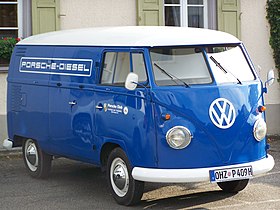
Volkswagen Type 2
Volkswagen panel van / From Wikipedia, the free encyclopedia
Dear Wikiwand AI, let's keep it short by simply answering these key questions:
Can you list the top facts and stats about Volkswagen Type 2?
Summarize this article for a 10 year old
The Volkswagen Type 2 is a forward control light commercial vehicle introduced in 1950 by the German automaker Volkswagen as its second car model. Known officially (depending on body type) as the Transporter, Kombi or Microbus, or, informally, as the Volkswagen Station Wagon[2] (US), Bus[2] (also US), Camper (UK) or Bulli (Germany), it was given the factory designation Type 2 as it followed – and was initially derived from – Volkswagen's first model, the Type 1 (Beetle).[3]
It has been suggested that this article should be split into a new article titled Talk:Volkswagen_Type_2#Divide-unbundle_the_first_and_second_generations_page. (discuss) (April 2024) |
| Volkswagen Type 2 | |
|---|---|
 | |
| Overview | |
| Manufacturer | Volkswagen |
| Also called |
|
| Production | November 1949[1] – present |
| Body and chassis | |
| Class | Light commercial vehicle (M) |
| Body style | |
| Layout |
|
| Platform | Volkswagen Group T platform |
| Chronology | |
| Successor | Volkswagen ID. Buzz (Type 2 RWD) |
As one of the forerunners of the modern cargo and passenger vans, the Type 2 gave rise to forward control competitors in the United States in the 1960s, including the Ford Econoline, the Dodge A100, and the Chevrolet Corvair 95 Corvan, the latter adapting the rear-engine configuration of the Corvair car in the same manner in which the VW Type 2 adapted the Type 1 layout.
European competition included the 1947–1981 Citroën H Van, the 1959–1980 Renault Estafette (both FF layout), the 1952–1969 semi forward-control Bedford CA and the 1953–1965 FR layout Ford Transit. Japanese manufacturers also introduced similar vehicles, such as the Nissan Caravan, Toyota LiteAce and Subaru Sambar. Like the Beetle, the van has received numerous nicknames worldwide, including the "microbus", "minibus",[4] and, because of its popularity during the counterculture movement of the 1960s, "Hippie van/bus".
Brazil contained the last factory in the world that produced the T2 series of Type 2, which ceased production on 31 December 2013, due to the introduction of more stringent safety regulations in the country.[5] This (after the 2002 termination of its T3 successor in South Africa) marked the end of the era of rear-engine Volkswagens, which originated in 1935 with their Type 1 prototypes.